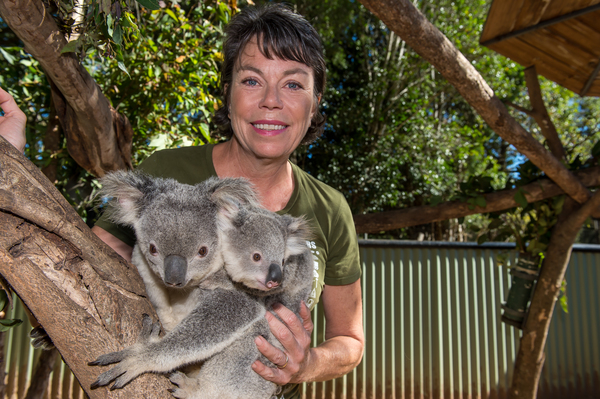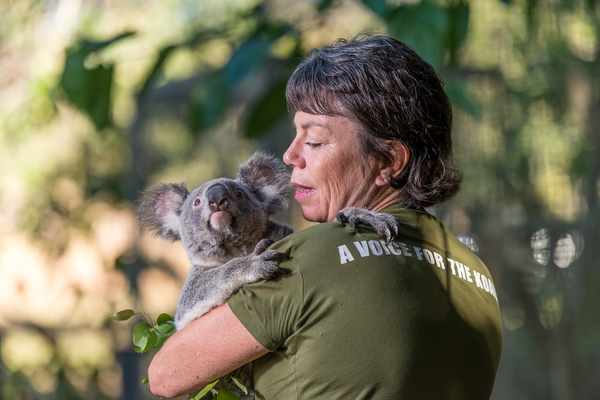Queensland Koala Crusaders president Meghan Halverson believes without action this may be the last generation to see wild koalas.
A New Yorker Meghan arrived in Australia in 2009, and while volunteering with Australia Zoo became aware of the increasing numbers of koalas admitted to the wildlife hospital for illness or injury with not all returning to the wild.
Coming from urbanised areas of the US, Meghan and her husband were astounded at their ability to walk through Noosa Heads National Park and see wild koalas.
When they first arrived, it was almost a certainty to see a koala on any visit.
That’s not the situation now.
“In the national park there’s four koalas we keep an eye on, but we’re hopeful there’s at least 12,” she said.
“They move around a lot. We’ve seen them on Hastings Street. They go to Laguna Lookout. Sunshine Beach has a couple. It’s still not a sustainable number”.
Last week a koala named Hilarie was returned to the park after being treated at Australia Zoo for the sexually transmitted disease chlamydia.
Queensland Koala Crusaders was formed by members drawn from existing koala advocacy groups and followed the Sunshine Coast Koala Summit held in 2012.
The group’s aims include the creation of safe havens and corridors for koalas, raising public awareness of their plight and bringing together researchers and conservation organisations.
A separate ambition is to set up a wild koala habitat combined with tourism and education potential.
“The ultimate goal is to have a sanctuary so people can go and see koalas in the wild,” Meghan said.
“It would depend on where we could acquire land”.
Potential sites identified by the group include the vacant Noosa TAFE which backs on to koala habitat and would be an ideal environmental centre, but this goal requires funds the group is yet to obtain.
Currently the group is working to create more communities so koalas can thrive on their own.
It has worked with both the Sunshine Coast and Noosa councils on their koala management plans.
Meghan said the “collaborative effort” with Noosa Council had encouraged her to “think this community can make a difference.”
And there is no time to lose with the situation she believes having become “critical”.
“We’re running out of space for koalas and we’re running out of koalas,” she said.
She said Queensland was clearing land at a rate of 300,000 hectares a year which is worse than that occurring in the rainforests of South America or Borneo and the situation is becoming dire for koalas.
“If you look at the land clearing already, it’s land we can’t replace,” she said.
“(Developers) offset the trees but it may not be where the koalas are and it may be seven years before the trees provide food.”
Determining the remaining numbers of koalas in the region is a project underway with only gestimates having been relied on to date.
The group believes these indicate there has been an 80-90 per cent drop in south east Queensland in the past few years. Meghan said anecdotally people said they used to see koalas all the time but now said they hadn’t seen one in years.
The group has been supporting research being carried out at the University of the Sunshine Coast (USC) through funding of equipment used with detection dogs.
USC molecular ecologist Celine Frere has been mapping the numbers and whereabouts of koalas across the Noosa Shire with their help and funding from the Noosa Biosphere Reserve Foundation (NBRF).
Celine said recent research focused on areas where there were no records of koala populations using the dogs trained ability to detect the smell of koala scats (poo).
She said the completed field work resulted in the collection of 128 scats that will now be sent for genetic analysis.
The analysis will determine whether the koalas are inbred or closely related and from this information, they can deduce where they have come from, she said.
Celine’s research has already enabled mapping of the location of koalas in the region.
She said one of the surprising results was the finding of koalas in unexpected places.
“It is showing us koalas are living in an urban footprint,” she said.
Celine said while people expected to find koalas in pristine native habitat the research found they were living in trees beside roads and in degraded areas.
She said much more research was needed to find out more about the complicated species.
Celine hopes to continue research with NBRF funding under its big ideas project while other research at USC is also looking for funding.
USC microbiologists, Professor Peter Timms and Dr Adam Polkinghorne, have spent years developing a vaccine to fight chlamydia, and after a series of trials in captive animals, they have conducted the world’s first successful trial of a vaccine against chlamydia in koalas in the wild.
While the success of the project has shown good immune responses to the vaccine, and importantly, decreased chlamydia infection levels, it relies on more funding to progress.
Meghan said the sharing of knowledge was among the aims of Queensland Koala Crusaders.
“Ongoing our focus is to work together,” she said.
“If we keep working in isolation, we’ll never make a difference.
“We need to have a consistent plan where we all work together.”
Preserving those surviving koalas depends of several factors including the enlisting of landowners to plant koala food trees, the control of dogs and looking at ways to reduce road kills.
“We have to look at the roads,” she said.
“There are underpasses on Eenie Creek Road but they’re not well maintained. “The trees hang over the road. The koalas can get on to the road.
“It’s not natural for koalas to go underground. We should look at land bridges”
During Save the Koala month of September, the Queensland Koala Crusaders are crowdfunding to raise $30,000 to plant 10,000 koala food trees and to encourage more people to join them.
She said their website had 28,000 likes, but “koalas don’t need likes they need leaves”. She is urging people to donate the cost of a couple of cups of coffee to their cause. For more information, visit koalacrusaders.org.au







